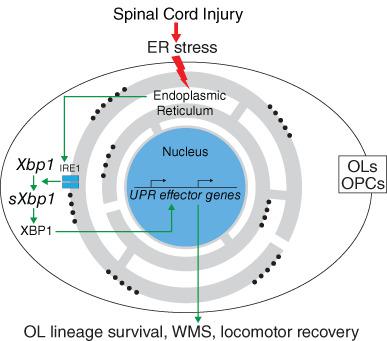Our official English website, www.x-mol.net, welcomes your
feedback! (Note: you will need to create a separate account there.)
Oligodendrocyte-specific deletion of Xbp1 exacerbates the endoplasmic reticulum stress response and restricts locomotor recovery after thoracic spinal cord injury.
Glia ( IF 5.4 ) Pub Date : 2020-09-14 , DOI: 10.1002/glia.23907 Sujata Saraswat Ohri 1, 2 , Russell M Howard 1, 2 , Yu Liu 1, 2 , Kariena R Andres 1, 2 , Courtney T Shepard 1, 3, 4 , Michal Hetman 1, 2, 3, 5 , Scott R Whittemore 1, 2, 3, 5
Glia ( IF 5.4 ) Pub Date : 2020-09-14 , DOI: 10.1002/glia.23907 Sujata Saraswat Ohri 1, 2 , Russell M Howard 1, 2 , Yu Liu 1, 2 , Kariena R Andres 1, 2 , Courtney T Shepard 1, 3, 4 , Michal Hetman 1, 2, 3, 5 , Scott R Whittemore 1, 2, 3, 5
Affiliation

|
The endoplasmic reticulum stress response (ERSR) is activated in various neurodegenerative diseases and/or after CNS traumatic injuries. The ERSR is comprised of three major arms, PERK, IRE‐1, and activating transcription factor‐6, with the latter two contributing to the unfolded protein response (UPR). PERK activity overlaps with the integrated stress response (ISR) kinases, PKR, HRI, and GCN2 which all signal through, eukaryotic initiation factor 2α, ATF4, and CHOP. All initially attempt to restore endoplasmic reticulum (ER) homeostasis, but if ER stress is unresolved, ATF4/CHOP‐mediated cell death is initiated. Here, we investigate the contribution of the inositol‐requiring protein‐1α‐X‐box binding protein‐1 (XBP1)‐mediated UPR signaling pathway to the pathogenesis of spinal cord injury (SCI). We demonstrate that deletion of Xbp1 caused an exacerbated ATF4/CHOP signaling in cultured mouse oligodendrocyte (OL) progenitor cells and enhanced their sensitivity to ER stress. Similar effects were also observed with the Xbp1 pathway inhibitor toyocamycin. Furthermore, OL lineage‐specific loss of Xbp1 resulted in enhanced ISR in mice that underwent moderate contusive SCI at the T9 level. Consistently, post‐injury recovery of hindlimb locomotion and white matter sparing were reduced in OL Xbp1‐deficient mice, which correlated with chronically decreased relative density of OPCs and OLs at the injury epicenter at 6 weeks post‐SCI. We conclude that the IRE1‐XBP1‐mediated UPR signaling pathway contributes to restoration of ER homeostasis in OLs and is necessary for enhanced white matter sparing and functional recovery post‐SCI.
中文翻译:

Xbp1 的少突胶质细胞特异性缺失会加剧内质网应激反应并限制胸脊髓损伤后的运动恢复。
内质网应激反应(ERSR)在各种神经退行性疾病和/或中枢神经系统创伤后被激活。 ERSR 由三个主要臂组成:PERK、IRE-1 和激活转录因子-6,后两者有助于未折叠蛋白反应 (UPR)。 PERK 活性与整合应激反应 (ISR) 激酶、PKR、HRI 和 GCN2 重叠,这些激酶均通过真核起始因子 2α、ATF4 和 CHOP 发出信号。所有这些最初都试图恢复内质网 (ER) 稳态,但如果 ER 应激未解决,ATF4/CHOP 介导的细胞死亡就会启动。在这里,我们研究了肌醇需求蛋白-1α-X-box结合蛋白-1(XBP1)介导的UPR信号通路对脊髓损伤(SCI)发病机制的贡献。我们证明, Xbp1的缺失导致培养的小鼠少突胶质细胞 (OL) 祖细胞中 ATF4/CHOP 信号传导加剧,并增强了它们对 ER 应激的敏感性。 Xbp1通路抑制剂丰加霉素也观察到类似的效果。此外, Xbp1的 OL 谱系特异性缺失导致在 T9 水平经历中度挫伤性 SCI 的小鼠 ISR 增强。一致的是,OL Xbp1缺陷小鼠的后肢运动恢复和白质保留均减少,这与 SCI 后 6 周损伤中心 OPC 和 OL 相对密度的长期下降相关。我们的结论是,IRE1-XBP1 介导的 UPR 信号通路有助于恢复 OL 中的 ER 稳态,并且对于增强 SCI 后白质保护和功能恢复是必要的。
更新日期:2020-09-14
中文翻译:

Xbp1 的少突胶质细胞特异性缺失会加剧内质网应激反应并限制胸脊髓损伤后的运动恢复。
内质网应激反应(ERSR)在各种神经退行性疾病和/或中枢神经系统创伤后被激活。 ERSR 由三个主要臂组成:PERK、IRE-1 和激活转录因子-6,后两者有助于未折叠蛋白反应 (UPR)。 PERK 活性与整合应激反应 (ISR) 激酶、PKR、HRI 和 GCN2 重叠,这些激酶均通过真核起始因子 2α、ATF4 和 CHOP 发出信号。所有这些最初都试图恢复内质网 (ER) 稳态,但如果 ER 应激未解决,ATF4/CHOP 介导的细胞死亡就会启动。在这里,我们研究了肌醇需求蛋白-1α-X-box结合蛋白-1(XBP1)介导的UPR信号通路对脊髓损伤(SCI)发病机制的贡献。我们证明, Xbp1的缺失导致培养的小鼠少突胶质细胞 (OL) 祖细胞中 ATF4/CHOP 信号传导加剧,并增强了它们对 ER 应激的敏感性。 Xbp1通路抑制剂丰加霉素也观察到类似的效果。此外, Xbp1的 OL 谱系特异性缺失导致在 T9 水平经历中度挫伤性 SCI 的小鼠 ISR 增强。一致的是,OL Xbp1缺陷小鼠的后肢运动恢复和白质保留均减少,这与 SCI 后 6 周损伤中心 OPC 和 OL 相对密度的长期下降相关。我们的结论是,IRE1-XBP1 介导的 UPR 信号通路有助于恢复 OL 中的 ER 稳态,并且对于增强 SCI 后白质保护和功能恢复是必要的。









































 京公网安备 11010802027423号
京公网安备 11010802027423号